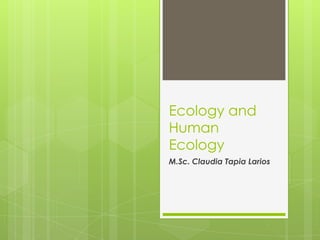
Ecology and human ecology
- 1. Ecology and Human Ecology M.Sc. Claudia Tapia Larios
- 2. Ecology Is the scientific study of the relations that living organisms have with respect to each other and their natural environment. Variables of interest to ecologists include the composition, distribution, amount (biomass), number, and changing states of organisms within and among ecosystems.
- 3. Ecosystems Ecosystems are hierarchical systems that are organized into a graded series of regularly interacting and semi- independent parts (e.g., species) that aggregate into higher orders of complex integrated wholes.
- 4. Ecosystems Ecosystems create biophysical feedback mechanisms between living (biotic) and nonliving (abiotic) components of the planet. These feedback loops regulate and sustain local communities, continental climate systems, and global biogeochemical cycles.
- 5. Human ecology Ecology is a human science as well. There are many practical applications of ecology in conservation biology, wetland management, natural resource management (agriculture, forestry, fisheries), city planning (urban ecology), community health, economics, basic and applied science and human social interaction (human ecology). Ecosystems sustain every life- supporting function on the planet, including climate regulation, water filtration, soil formation (pedogenesis), food, fibers, medicines, erosion control, and many other natural features of scientific, historical
- 6. Human ecology Human ecology and human behavior are the two key factors that determine the transmission of human infectious diseases. When the cycle of transmission includes mosquitoes, ticks, rode nts or other intermediaries, their ecology and behavior are also critical.
- 7. When multiple species are involved, the levels of complexity are even greater. Lastly, the virulence of the pathogen, the susceptibility of its vectors and hosts, the immunity of those hosts and the collective immunity of the host populations all contribute to the force of transmission. The significance of climate factors can only be assessed in the perspective of this daunting complexity.
- 8. Human ecology as a science Climate and weather are often invoked as the dominant parameters in transmission, but their true significance can only be assessed in the perspective of this daunting complexity. Moreover, the key parameters – temperature, rainfall and humidity – cannot be viewed independently. The effects of temperature are modified by humidity. The daily range of each may be more significant than the daily mean. Brief periods of atypical heat or cold can be more significant than long-term averages. Heavy storms can have a different impact than light prolonged rainfall. One year’s events may have a significant impact on subsequent years.
- 9. Climate and current distributions of disease The distribution of many diseases coincides with certain climate patterns, but in many cases the reverse does not hold true. For example, malaria disappeared “spontaneously” from large areas of Western Europe and North America after the mid-1800s, precisely the period when the current warming trend began (Reiter 2001).
